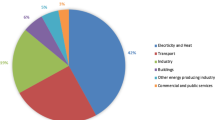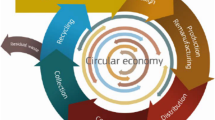Abstract
Best Available Techniques (BATs) contribute significantly to the reduction of industrial environmental burdens with respect to air pollution, wastewater, and solid wastes. In Europe, the application of BATs is prescribed by Directive 96/61/EC, which, however, leaves the selection of specific BATs to plant operators. In making their choices, installations have to consider not only the environmental benefits of BATs, but also all relevant cost components. In assessing the economic attractiveness of potential BATs and their combinations, as well as incentives and disincentives to be instituted, the cost of environmental externalities, usually not reflected in market prices, should be taken into account. In this paper, a decision-aid framework combining an assessment of environmental externalities and the utilization of multicriteria methods and, more specifically, Multiobjective Mathematical Programming, capable of addressing all these issues in a comprehensive and coherent manner, is presented. This is illustrated by its application for the region of Attica in Greece, where over 50% of the industrial basis and Athens, with its 4 million inhabitants, are located. The implementation of the framework and its associated tools to 800 installations led to the identification of the specific BATs, alone or in combination, that provide the most cost-effective reductions of four air pollutants (PM10, SO2, NOx, VOC) and CO2. The results also clearly demonstrate the increased pollution reductions that would result from the adoption of BATs made economically attractive by the inclusion of externalities. Estimates of investments and net present values with and without incentives/disincentives are also provided.









Similar content being viewed by others
References
Agrel PJ, Stam A, Fischer GW (2004) Interactive multiobjective agro-ecological land use planning: the Bungoma region in Kenya. European Journal of Operational Research 158:194–217
Bazzani G (2005) An integrated decision support system for irrigation and water policy design: DSIRR. Environmental Modeling & Software 20:153–163
Charnes A, Cooper WW (1961) Management models and industrial applications of linear programming. John Wiley and Sons, New York, 467 pp
Cohon JL (1978) Multiobjective programming and planning. Academic Press, New York, 352 pp
Ehrgott M, Wiecek M (2005) Multiobjective programming. In: Figueira J, Greco S, Ehrgott M (eds.), Multiple criteria decision analysis. State of the Art Surveys. Springer, New York, pp 667–722
EPEM SA, LDK Ltd, ENVECO SA, EXERGIA SA, SIVILLA SA (2001) Inventory of air emissions, solid and liquid wastes from industry and air emissions from central heating installations. Final Project Report. Athens (in Greek)
Evans GW (1984) An overview of techniques for multiobjective mathematical programs. Management Science 30:1268–1282
European Commission (1995) ExternE, externalities of energy. ExternE Project Report Vol 2: Methodology. European Commission, DG XII Science, Research and Development, Luxembourg, 252 pp
European Commission (2004) New elements for the assessment of external costs from energy technologies (NewExt). Final Project Report. DG Research, Technological Development and Demonstration (RTD), Brussels, 333 pp
European Commission (2005a) Reference document on economics and cross-media effects. DG Joint Research Centre, Seville, Spain, 177 pp
European Commission (2005b) ExternE: externalities of energy—methodology 2005 Update. DG Research, Technological Development and Demonstration (RTD), Luxembourg, 270 pp
European Environment Agency (2001) Joint EMEP/CORINAIR atmospheric emission inventory guidebook. 3rd ed. October 2002 Update. Technical report No. 30. EEA, Copenhagen, 1750 pp
Geldermann J, Rentz O (2001) Integrated technique assessment with imprecise information as a support for the identification of best available techniques (BAT). OR Spektrum 23:137–157
Geldermann J, Rentz O (2004) The reference installation approach for the techno-economic assessment of emission abatement options and the determination of BAT according to the IPPC-directive. Journal of Cleaner Production 12:389–402
Georgopoulou E, Lalas DP, Papagiannakis L (1997) A Multicriteria Decision Aid approach for energy planning problems: The case of renewable energy option. European Journal of Operational Research 103:38–54
Georgopoulou E, Sarafidis Y, Mirasgedis S, Zaimi S, Lalas DP (2003) A multiple criteria decision-aid approach in defining national priorities for greenhouse gases emissions reduction in the energy sector. European Journal of Operational Research 146:199–215
Hellenic Ministry for the Environment, Physical Planning and Public Works (HMEPPPW) 1998–2001. Sectoral studies for the implementation of the IPPC Directive in Greece. HMEPPPW, Athens (in Greek)
Ignizio JP (1982) Linear programming in single- & multiple-objective systems. Prentice-Hall, Englewood Cliffs, NJ, 506 pp
Intergovernmental Panel on Climate Change (1997) Revised 1996 IPCC guidelines for national greenhouse gas inventories—Greenhouse gas inventory reference manual. IPCC/OECD/IEA, UK Meteorological Office, Bracknell, 496 pp
Lahdelmaa R, Salminen P, Hokkanen H (2002) Locating a waste treatment facility by using stochastic multicriteria acceptability analysis with ordinal criteria. European Journal of Operational Research 142:345–356
Mavrotas G, Georgopoulou E, Mirasgedis S, Sarafidis Y, Lalas D, Hontou V (2006) Evaluation and selection of Best Available Techniques (BAT) for the industries in greater Athens area using multiobjective combinatorial optimization. In: Proceedings of the 19th Mini-EURO Conference ORMMES 2006, Operational Research Models and Methods in the Energy Sector, Coimbra-Portugal, 6–8 September
Mirasgedis S, Diakoulaki D (1997) Multicriteria analysis vs. externalities assessment for the comparative evaluation of electricity generation systems. European Journal of Operational Research 102:364–379
National Observatory of Athens (NOA), Hellenic Ministry for the Environment, Physical Planning and Public Works (HMEPPPW) (2005) Climate change emissions inventory: national inventory for greenhouse and other gases for the years 1990–2003. HMEPPPW–NOA, Athens, 257 pp
National Observatory of Athens (NOA), EPEM SA, KPMG SA, LDK Ltd (2004) Development of a database for the installations under the EU Emissions Trading Directive. Project Report No. 1. NOA, Athens, 372 pp. (in Greek)
National Observatory of Athens (NOA), EPEM SA, LDK Ltd (2006) Decision Aid Framework for the assessment of impacts from the introduction of Best Available Techniques in industry (DAF-BAT). Project Reports Nos. 1–15. NOA, Athens, 1339 pp. (in Greek)
Pearce DW, Markandya A (1989) Environmental policy benefits: monetary valuation. Organisation for Economic Co-operation and Development, Paris, 83 pp
Schleisner L (2000) Comparison of methodologies for externality assessment. Energy Policy 28:1127–1136
Scottish Environment Protection Agency–Northern Ireland Environment and Heritage Service (2003) Integrated pollution prevention and control (IPPC)—environmental Assessment and Appraisal of BAT. Horizontal Guidance Note IPPC H1, Bristol, 127 pp
Steuer RE (1989) Multiple criteria optimization: theory, computation and application. Krieger, Malabar, FL, 546 pp
United States Environment Protection Agency 1995–2005. AP 42/fifth edition—compilation of air pollutant emission factors. Vol 1: Stationary point and area sources. Technology Transfer Network Clearinghouse for Inventories & Emissions Factors. Available at: http://www.epa.gov/ttn/chief/ap42/index.html
United States Environment Protection Agency (2002) EPA air pollution control cost manual. 6th ed. EPA/452/B-02-001. National Technical Information Service, Springfield, VA, 752 pp
World Health Organization (2000) Air quality guidelines for Europe. European Series No 91. WHO Regional Publications, Copenhagen, 273 pp
Zeleny M (1981) The pros and cons of goal programming. Computers and Operational Research 8:357–359
Acknowledgments
The work presented in this paper has been carried out in the scope of a recently completed research project on the implementation of BATs in the Greek industry supported by the General Secretariat of Research and Technology of the Ministry of Development of Greece (National Observatory of Athens and others 2006).
Author information
Authors and Affiliations
Corresponding author
Rights and permissions
About this article
Cite this article
Georgopoulou, E., Mirasgedis, S., Sarafidis, Y. et al. A Decision-Aid Framework to Provide Guidance for the Enhanced Use of Best Available Techniques in Industry. Environmental Management 40, 413–429 (2007). https://doi.org/10.1007/s00267-006-0131-z
Received:
Accepted:
Published:
Issue Date:
DOI: https://doi.org/10.1007/s00267-006-0131-z




